The Role of Two-Pore Channels in Norepinephrine-Induced [Ca2+]i Rise in Rat Aortic Smooth Muscle Cells and Aorta Contraction
Abstract
:1. Introduction
2. Materials and Methods
2.1. Reagents
2.2. Animals
2.3. Registration of Aorta Contraction
2.4. Cell Culture
2.5. Measurement of Free Cytoplasmic Calcium Concentration in SMCs and HUVECs
2.6. Measurement of mRNA Coding TPC1 and TPC2 in SMCs
2.7. Western Blot
2.8. Fluorescent Staining of TPC and Lysosomes in SMCs
2.9. siRNA Transfection
2.10. Statistics
3. Results
3.1. TPC Expression and Localization in Rat Aorta SMCs
3.2. Study of the Effects of NED 19 on the Agonist-Induced [Ca2+]i Elevation in SMCs
3.3. Inhibition of [Ca2+]i Elevation in Response to NE by siRNA Against TPC1
3.4. Study of NED 19 Effects on Rat Aorta Contraction in Response to NE, Arg-Vasopressin, Angiotensin II, and 5-HT
3.5. Study of Bafilomycin A1 Effects on NE-Induced [Ca2+]i Elevation in SMCs and on the Aortic Tone
4. Discussion
Author Contributions
Funding
Acknowledgments
Conflicts of Interest
References
- Galione, A.; Lee, H.C.; Busa, W.B. Ca(2+)-Induced Ca2+ Release in Sea Urchin Egg Homogenates: Modulation by Cyclic ADP-Ribose. Science 1991, 253, 1143–1146. [Google Scholar] [CrossRef] [PubMed]
- Singaravelu, K.; Deitmer, J.W. Calcium Mobilization by Nicotinic Acid Adenine Dinucleotide Phosphate (NAADP) in Rat Astrocytes. Cell Calcium 2006, 39, 143–153. [Google Scholar] [CrossRef] [PubMed]
- Lee, H.C.; Aarhus, R. A Derivative of NADP Mobilizes Calcium Stores Insensitive to Inositol Trisphosphate and Cyclic ADP-Ribose. J. Biol. Chem. 1995, 270, 2152–2157. [Google Scholar] [CrossRef] [PubMed]
- Churchill, G.C.; Okada, Y.; Thomas, J.M.; Genazzani, A.A.; Patel, S.; Galione, A. NAADP Mobilizes Ca(2+) from Reserve Granules, Lysosome-Related Organelles, in Sea Urchin Eggs. Cell 2002, 111, 703–708. [Google Scholar] [CrossRef]
- Guse, A.H.; Lee, H.C. NAADP: A Universal Ca2+ Trigger. Sci. Signal 2008, 1, re10. [Google Scholar] [CrossRef] [PubMed]
- Calcraft, P.J.; Ruas, M.; Pan, Z.; Cheng, X.; Arredouani, A.; Hao, X.; Tang, J.; Rietdorf, K.; Teboul, L.; Chuang, K.T.; et al. NAADP Mobilizes Calcium from Acidic Organelles through Two-Pore Channels. Nature 2009, 459, 596–600. [Google Scholar] [CrossRef] [PubMed]
- Zong, X.; Schieder, M.; Cuny, H.; Fenske, S.; Gruner, C.; Rotzer, K.; Griesbeck, O.; Harz, H.; Biel, M.; Wahl-Schott, C. The Two-Pore Channel TPCN2 Mediates NAADP-Dependent Ca(2+)-Release from Lysosomal Stores. Pflug. Arch. 2009, 458, 891–899. [Google Scholar] [CrossRef] [PubMed]
- Brailoiu, E.; Churamani, D.; Cai, X.; Schrlau, M.G.; Brailoiu, G.C.; Gao, X.; Hooper, R.; Boulware, M.J.; Dun, N.J.; Marchant, J.S.; et al. Essential Requirement for Two-Pore Channel 1 in NAADP-Mediated Calcium Signaling. J. Cell Biol. 2009, 186, 201–209. [Google Scholar] [CrossRef]
- Ishibashi, K.; Suzuki, M.; Imai, M. Molecular Cloning of a Novel Form (Two-Repeat) Protein Related to Voltage-Gated Sodium and Calcium Channels. Biochem. Biophys. Res. Commun. 2000, 270, 370–376. [Google Scholar] [CrossRef]
- Wang, X.; Zhang, X.; Dong, X.P.; Samie, M.; Li, X.; Cheng, X.; Goschka, A.; Shen, D.; Zhou, Y.; Harlow, J.; et al. TPC Proteins Are Phosphoinositide- Activated Sodium-Selective Ion Channels in Endosomes and Lysosomes. Cell 2012, 151, 372–383. [Google Scholar] [CrossRef] [Green Version]
- Jha, A.; Ahuja, M.; Patel, S.; Brailoiu, E.; Muallem, S. Convergent Regulation of the Lysosomal Two-Pore Channel-2 by Mg(2)(+), NAADP, PI(3,5)P(2) and Multiple Protein Kinases. EMBO J. 2014, 33, 501–511. [Google Scholar] [CrossRef] [PubMed]
- Aley, P.K.; Mikolajczyk, A.M.; Munz, B.; Churchill, G.C.; Galione, A.; Berger, F. Nicotinic Acid Adenine Dinucleotide Phosphate Regulates Skeletal Muscle Differentiation Via Action at Two-Pore Channels. Proc. Natl. Acad. Sci. USA 2010, 107, 19927–19932. [Google Scholar] [CrossRef] [PubMed]
- Brailoiu, E.; Churamani, D.; Pandey, V.; Brailoiu, G.C.; Tuluc, F.; Patel, S.; Dun, N.J. Messenger-Specific Role for Nicotinic Acid Adenine Dinucleotide Phosphate in Neuronal Differentiation. J. Biol. Chem. 2006, 281, 15923–15928. [Google Scholar] [CrossRef] [PubMed]
- Esposito, B.; Gambara, G.; Lewis, A.M.; Palombi, F.; D’Alessio, A.; Taylor, L.X.; Genazzani, A.A.; Ziparo, E.; Galione, A.; Churchill, G.C.; et al. NAADP Links Histamine H1 Receptors to Secretion of von Willebrand Factor in Human Endothelial Cells. Blood 2011, 117, 4968–4977. [Google Scholar] [CrossRef] [PubMed]
- Masgrau, R.; Churchill, G.C.; Morgan, A.J.; Ashcroft, S.J.; Galione, A. NAADP: A New Second Messenger for Glucose-Induced Ca2+ Responses in Clonal Pancreatic Beta Cells. Curr. Biol. 2003, 13, 247–251. [Google Scholar] [CrossRef]
- Yamasaki, M.; Masgrau, R.; Morgan, A.J.; Churchill, G.C.; Patel, S.; Ashcroft, S.J.; Galione, A. Organelle Selection Determines Agonist-Specific Ca2+ Signals in Pancreatic Acinar and Beta Cells. J. Biol. Chem. 2004, 279, 7234–7240. [Google Scholar] [CrossRef] [PubMed]
- Aley, P.K.; Noh, H.J.; Gao, X.; Tica, A.A.; Brailoiu, E.; Churchill, G.C. A Functional Role for Nicotinic Acid Adenine Dinucleotide Phosphate in Oxytocin-Mediated Contraction of Uterine Smooth Muscle from Rat. J. Pharm. Exp. 2010, 333, 726–735. [Google Scholar] [CrossRef] [Green Version]
- Tugba Durlu-Kandilci, N.; Ruas, M.; Chuang, K.T.; Brading, A.; Parrington, J.; Galione, A. TPC2 Proteins Mediate Nicotinic Acid Adenine Dinucleotide Phosphate (NAADP)- and Agonist-Evoked Contractions of Smooth Muscle. J. Biol. Chem. 2010, 285, 24925–24932. [Google Scholar] [CrossRef]
- Rah, S.Y.; Lee, Y.H.; Kim, U.H. NAADP-Mediated Ca2+ Signaling Promotes Autophagy and Protects against LPS-Induced Liver Injury. FASEB J. 2017, 31, 3126–3137. [Google Scholar] [CrossRef]
- Brailoiu, G.C.; Gurzu, B.; Gao, X.; Parkesh, R.; Aley, P.K.; Trifa, D.I.; Galione, A.; Dun, N.J.; Madesh, M.; Patel, S.; et al. Acidic NAADP-Sensitive Calcium Stores in the Endothelium: Agonist-Specific Recruitment and Role in Regulating Blood Pressure. J. Biol. Chem. 2010, 285, 37133–37137. [Google Scholar] [CrossRef]
- Boittin, F.X.; Galione, A.; Evans, A.M. Nicotinic Acid Adenine Dinucleotide Phosphate Mediates Ca2+ Signals and Contraction in Arterial Smooth Muscle via a Two-Pool Mechanism. Circ. Res. 2002, 91, 1168–1175. [Google Scholar] [CrossRef] [PubMed]
- Jiang, Y.L.; Lin, A.H.; Xia, Y.; Lee, S.; Paudel, O.; Sun, H.; Yang, X.R.; Ran, P.; Sham, J.S. Nicotinic Acid Adenine Dinucleotide Phosphate (NAADP) Activates Global and Heterogeneous Local Ca2+ Signals from NAADP- and Ryanodine Receptor-Gated Ca2+ Stores in Pulmonary Arterial Myocytes. J. Biol. Chem. 2013, 288, 10381–10394. [Google Scholar] [CrossRef] [PubMed]
- Kinnear, N.P.; Boittin, F.X.; Thomas, J.M.; Galione, A.; Evans, A.M. Lysosome-Sarcoplasmic Reticulum Junctions. A Trigger Zone for Calcium Signaling by Nicotinic Acid Adenine Dinucleotide Phosphate and Endothelin-1. J. Biol. Chem. 2004, 279, 54319–54326. [Google Scholar] [CrossRef] [PubMed]
- Lee, S.; Paudel, O.; Jiang, Y.; Yang, X.R.; Sham, J.S. CD38 Mediates Angiotensin II-Induced Intracellular Ca(2+) Release in Rat Pulmonary Arterial Smooth Muscle Cells. Am. J. Respir. Cell Mol. Biol. 2015, 52, 332–341. [Google Scholar] [CrossRef] [PubMed]
- Thai, T.L.; Churchill, G.C.; Arendshorst, W.J. NAADP Receptors Mediate Calcium Signaling Stimulated by Endothelin-1 and Norepinephrine in Renal Afferent Arterioles. Am. J. Physiol. Ren. Physiol. 2009, 297, F510–F516. [Google Scholar] [CrossRef] [PubMed]
- Zhang, F.; Zhang, G.; Zhang, A.Y.; Koeberl, M.J.; Wallander, E.; Li, P.L. Production of NAADP and Its Role in Ca2+ Mobilization Associated with Lysosomes in Coronary Arterial Myocytes. Am. J. Physiol. Heart Circ. Physiol. 2006, 291, H274–H282. [Google Scholar] [CrossRef]
- Naylor, E.; Arredouani, A.; Vasudevan, S.R.; Lewis, A.M.; Parkesh, R.; Mizote, A.; Rosen, D.; Thomas, J.M.; Izumi, M.; Ganesan, A.; et al. Identification of a Chemical Probe for NAADP by Virtual Screening. Nat. Chem Biol 2009, 5, 220–226. [Google Scholar] [CrossRef] [PubMed]
- Xu, S.; Fu, J.; Chen, J.; Xiao, P.; Lan, T.; Le, K.; Cheng, F.; He, L.; Shen, X.; Huang, H.; et al. Development of an Optimized Protocol for Primary Culture of Smooth Muscle Cells from Rat Thoracic Aortas. Cytotechnology 2009, 61, 65–72. [Google Scholar] [CrossRef] [PubMed]
- Jaffe, E.A.; Nachman, R.L.; Becker, C.G.; Minick, C.R. Culture of Human Endothelial Cells Derived from Umbilical Veins. Identification by Morphologic and Immunologic Criteria. J. Clin. Invest. 1973, 52, 2745–2756. [Google Scholar] [PubMed]
- Goncharov, N.V.; Sakharov, I.; Danilov, S.M.; Sakandelidze, O.G. Use of Collagenase from the Hepatopancreas of the Kamchatka Crab for Isolating and Culturing Endothelial Cells of the Large Vessels in Man. Biull. Eksp. Biol. Med. 1987, 104, 376–378. [Google Scholar] [CrossRef]
- Maciag, T.; Cerundolo, J.; Ilsley, S.; Kelley, P.R.; Forand, R. An Endothelial Cell Growth Factor from Bovine Hypothalamus: Identification and Partial Characterization. Proc. Natl. Acad. Sci. USA 1979, 76, 5674–5678. [Google Scholar] [CrossRef] [PubMed]
- Singan, V.R.; Jones, T.R.; Curran, K.M.; Simpson, J.C. Dual Channel Rank-Based Intensity Weighting for Quantitative Co-Localization of Microscopy Images. BMC Bioinform. 2011, 12, 407. [Google Scholar] [CrossRef] [PubMed]
- Churamani, D.; Hooper, R.; Brailoiu, E.; Patel, S. Domain Assembly of NAADP-Gated Two-Pore Channels. Biochem. J. 2012, 441, 317–323. [Google Scholar] [CrossRef] [PubMed]
- Zharkich, I.L.; Nadeev, A.D.; Tsitrin, E.B.; Goncharov, N.V.; Avdonin, P.V. Suppression of Histamine Induced Relaxation of Rat Aorta and Calcium Signaling in Endothelial Cells by Two Pore Channel Blocker Trans-NED19 and Hydrogen Peroxide. Biol. Bull. 2016, 43, 365–372. [Google Scholar] [CrossRef]
- Favia, A.; Desideri, M.; Gambara, G.; D’Alessio, A.; Ruas, M.; Esposito, B.; Del Bufalo, D.; Parrington, J.; Ziparo, E.; Palombi, F.; et al. VEGF-Induced Neoangiogenesis Is Mediated by NAADP and Two-Pore Channel-2-Dependent Ca2+ Signaling. Proc. Natl. Acad. Sci. USA 2014, 111, E4706–E4715. [Google Scholar] [CrossRef] [PubMed]
- Benham, C.D.; Tsien, R.W. Noradrenaline Modulation of Calcium Channels in Single Smooth Muscle Cells from Rabbit Ear Artery. J. Physiol. 1988, 404, 767–784. [Google Scholar] [CrossRef]
- Eckert, R.E.; Karsten, A.J.; Utz, J.; Ziegler, M. Regulation of Renal Artery Smooth Muscle Tone by Alpha1-Adrenoceptors: Role of Voltage-Gated Calcium Channels and Intracellular Calcium Stores. Urol. Res. 2000, 28, 122–127. [Google Scholar] [CrossRef]
- Schmid, J.; Muller, B.; Heppeler, D.; Gaynullina, D.; Kassmann, M.; Gagov, H.; Mladenov, M.; Gollasch, M.; Schubert, R. The Unexpected Role of Calcium-Activated Potassium Channels: Limitation of NO-Induced Arterial Relaxation. J. Am. Heart Assoc. 2018, 7, e007808. [Google Scholar] [CrossRef] [PubMed]
- Pereira, G.J.; Hirata, H.; do Carmo, L.G.; Stilhano, R.S.; Ureshino, R.P.; Medaglia, N.C.; Han, S.W.; Churchill, G.; Bincoletto, C.; Patel, S.; et al. NAADP-Sensitive Two-Pore Channels Are Present and Functional in Gastric Smooth Muscle Cells. Cell Calcium 2014, 56, 51–58. [Google Scholar] [CrossRef] [PubMed]
- Bychkova, S.V.; Chorna, T.I. NAADP-Sensitive Ca2+ Stores in Permeabilized Rat Hepatocytes. Ukr Biochem. J. 2014, 86, 65–73. [Google Scholar] [CrossRef]
- Steen, M.; Kirchberger, T.; Guse, A.H. NAADP Mobilizes Calcium from the Endoplasmic Reticular Ca(2+) Store in T-Lymphocytes. J. Biol. Chem. 2007, 282, 18864–18871. [Google Scholar] [CrossRef] [PubMed]
- Aley, P.K.; Singh, N.; Brailoiu, G.C.; Brailoiu, E.; Churchill, G.C. Nicotinic Acid Adenine Dinucleotide Phosphate (NAADP) Is a Second Messenger in Muscarinic Receptor-Induced Contraction of Guinea Pig Trachea. J. Biol. Chem. 2013, 288, 10986–10993. [Google Scholar] [CrossRef] [PubMed]
- Govindan, S.; Taylor, C.W. P2Y Receptor Subtypes Evoke Different Ca2+ Signals in Cultured Aortic Smooth Muscle Cells. Purinergic Signal. 2012, 8, 763–777. [Google Scholar] [CrossRef] [PubMed]
- Penny, C.J.; Kilpatrick, B.S.; Eden, E.R.; Patel, S. Coupling Acidic Organelles with the ER through Ca(2)(+) Microdomains at Membrane Contact Sites. Cell Calcium 2015, 58, 387–396. [Google Scholar] [CrossRef] [PubMed]
- Zhu, M.X.; Ma, J.; Parrington, J.; Calcraft, P.J.; Galione, A.; Evans, A.M. Calcium Signaling Via Two-Pore Channels: Local or Global, That Is the Question. Am. J. Physiol. Cell Physiol. 2010, 298, C430–C441. [Google Scholar] [CrossRef] [PubMed]
- Patel, S.; Churchill, G.C.; Galione, A. Coordination of Ca2+ Signalling by NAADP. Trends Biochem. Sci. 2001, 26, 482–489. [Google Scholar] [CrossRef]
- Semenchuk, L.A.; Di Salvo, J. Receptor-Activated Increases in Intracellular Calcium and Protein Tyrosine Phosphorylation in Vascular Smooth Muscle Cells. FEBS Lett. 1995, 370, 127–130. [Google Scholar] [CrossRef]
- Oishi, H.; Budel, S.; Schuster, A.; Stergiopulos, N.; Meister, J.J.; Beny, J.L. Cytosolic-Free Calcium in Smooth-Muscle and Endothelial Cells in an Intact Arterial Wall from Rat Mesenteric Artery in vitro. Cell Calcium 2001, 30, 261–267. [Google Scholar] [CrossRef] [PubMed]
- Schuster, A.; Lamboley, M.; Grange, C.; Oishi, H.; Beny, J.L.; Stergiopulos, N.; Meister, J.J. Calcium Dynamics and Vasomotion in Rat Mesenteric Arteries. J. Cardiovasc. Pharm. 2004, 43, 539–548. [Google Scholar] [CrossRef] [PubMed]
- Leeb-Lundberg, L.M.; Cotecchia, S.; Lomasney, J.W.; DeBernardis, J.F.; Lefkowitz, R.J.; Caron, M.G. Phorbol Esters Promote Alpha 1-Adrenergic Receptor Phosphorylation and Receptor Uncoupling from Inositol Phospholipid Metabolism. Proc. Natl. Acad. Sci. USA 1985, 82, 5651–5655. [Google Scholar] [CrossRef] [PubMed]
- Mironneau, J.; Macrez-Lepretre, N. Modulation of Ca2+ Channels by Alpha 1A- and Alpha 2A-Adrenoceptors in Vascular Myocytes: Involvement of Different Transduction Pathways. Cell Signal. 1995, 7, 471–479. [Google Scholar] [CrossRef]
- Raeymaekers, L.; Nilius, B.; Voets, T.; Missiaen, L.; Van Baelen, K.; Vanoevelen, J.; Wuytack, F. Additional Fluxes of Activator Ca2+ Accompanying Ca2+ Release from the Sarcoplasmic Reticulum Triggered by insP3-Mobilizing Agonists. Novartis Found. Symp. 2002, 246, 71–76. [Google Scholar] [PubMed]
- Inoue, R.; Okada, T.; Onoue, H.; Hara, Y.; Shimizu, S.; Naitoh, S.; Ito, Y.; Mori, Y. The Transient Receptor Potential Protein Homologue TRP6 Is the Essential Component of Vascular Alpha(1)-Adrenoceptor-Activated Ca(2+)-Permeable Cation Channel. Circ. Res. 2001, 88, 325–332. [Google Scholar] [CrossRef] [PubMed]
- Pitt, S.J.; Reilly-O’Donnell, B.; Sitsapesan, R. Exploring the Biophysical Evidence That Mammalian Two-Pore Channels Are NAADP-Activated Calcium-Permeable Channels. J. Physiol. 2016, 594, 4171–4179. [Google Scholar] [CrossRef] [PubMed]
- Fameli, N.; Ogunbayo, O.A.; van Breemen, C.; Evans, A.M. Cytoplasmic Nanojunctions between Lysosomes and Sarcoplasmic Reticulum Are Required for Specific Calcium Signaling. F1000Res 2014, 3, 93. [Google Scholar] [CrossRef]
- Kinnear, N.P.; Wyatt, C.N.; Clark, J.H.; Calcraft, P.J.; Fleischer, S.; Jeyakumar, L.H.; Nixon, G.F.; Evans, A.M. Lysosomes Co-Localize with Ryanodine Receptor Subtype 3 to Form a Trigger Zone for Calcium Signalling by NAADP in Rat Pulmonary Arterial Smooth Muscle. Cell Calcium 2008, 44, 190–201. [Google Scholar] [CrossRef]
- Jiang, Y.; Zhou, Y.; Peng, G.; Tian, H.; Pan, D.; Liu, L.; Yang, X.; Li, C.; Li, W.; Chen, L.; et al. Two-Pore Channels Mediated Receptor-Operated Ca(2+) Entry in Pulmonary Artery Smooth Muscle Cells in Response to Hypoxia. Int. J. Biochem. Cell Biol. 2018, 97, 28–35. [Google Scholar] [CrossRef]

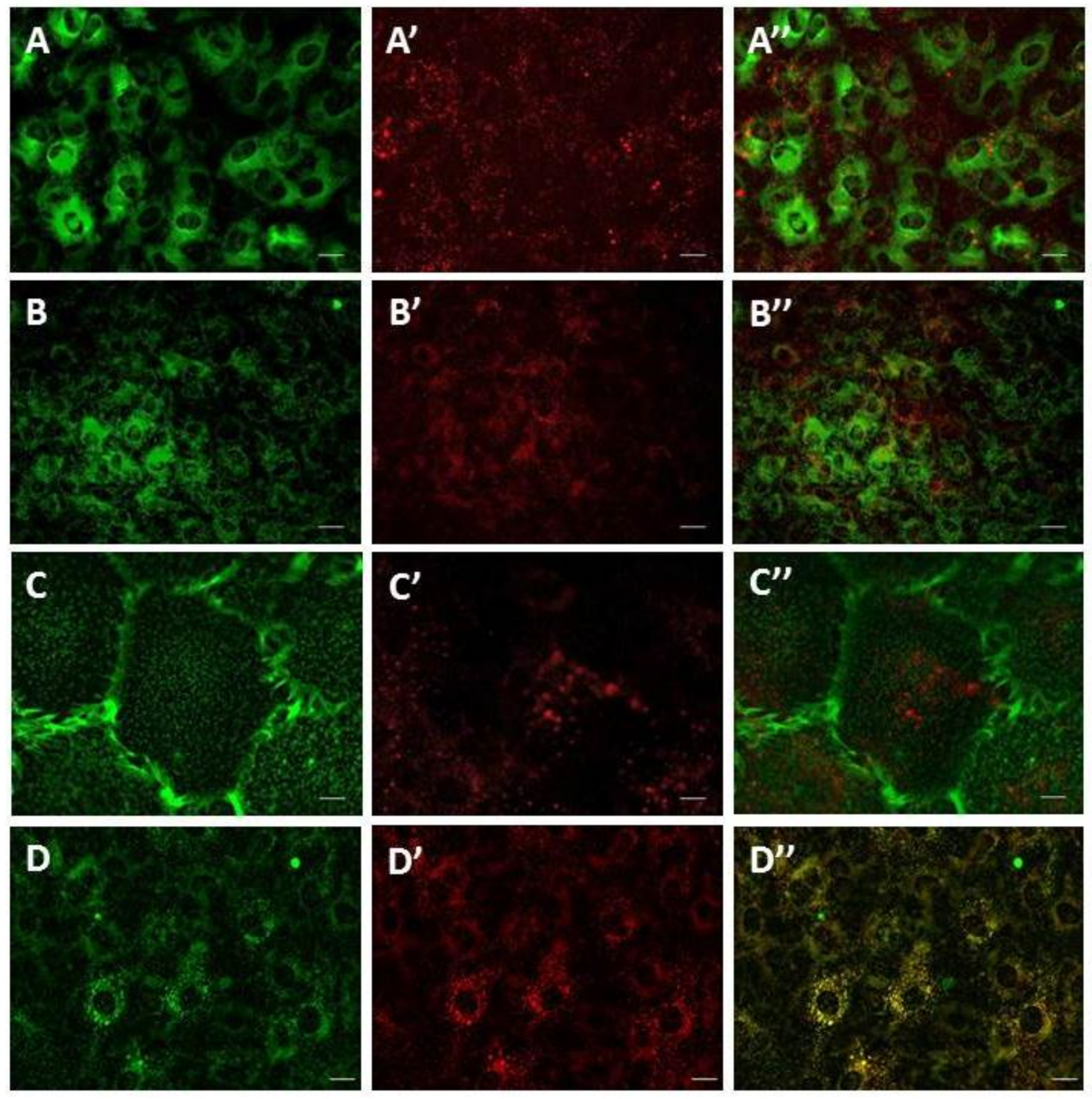

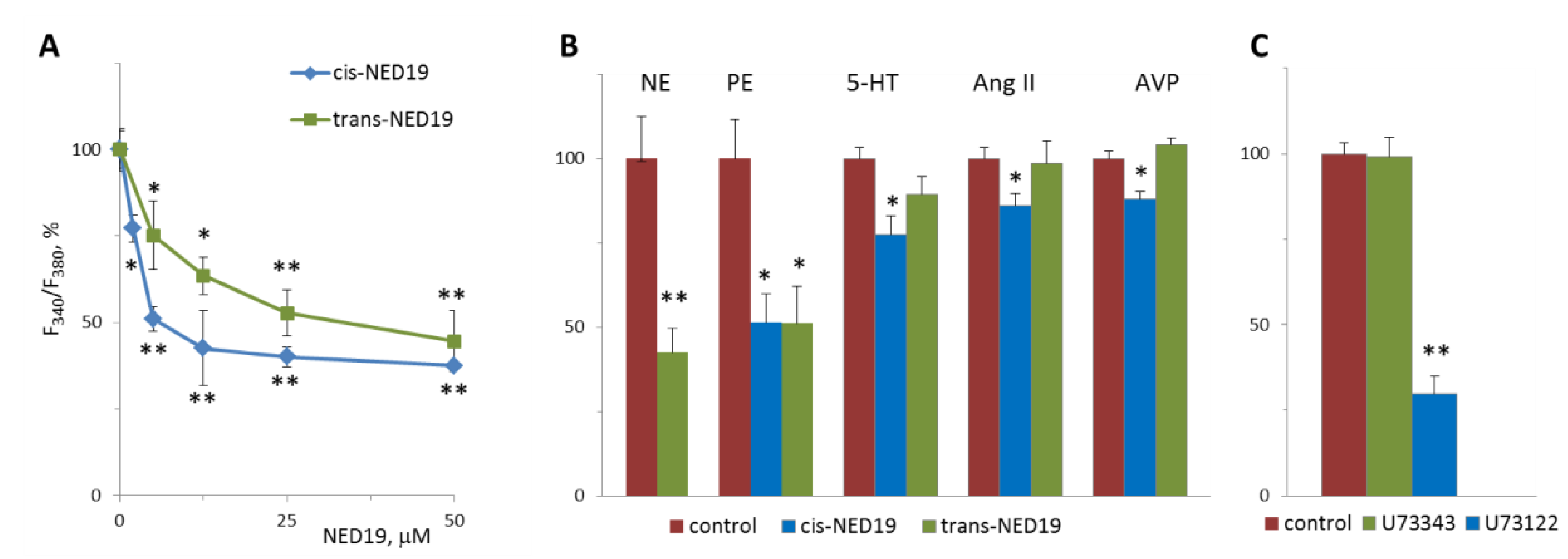
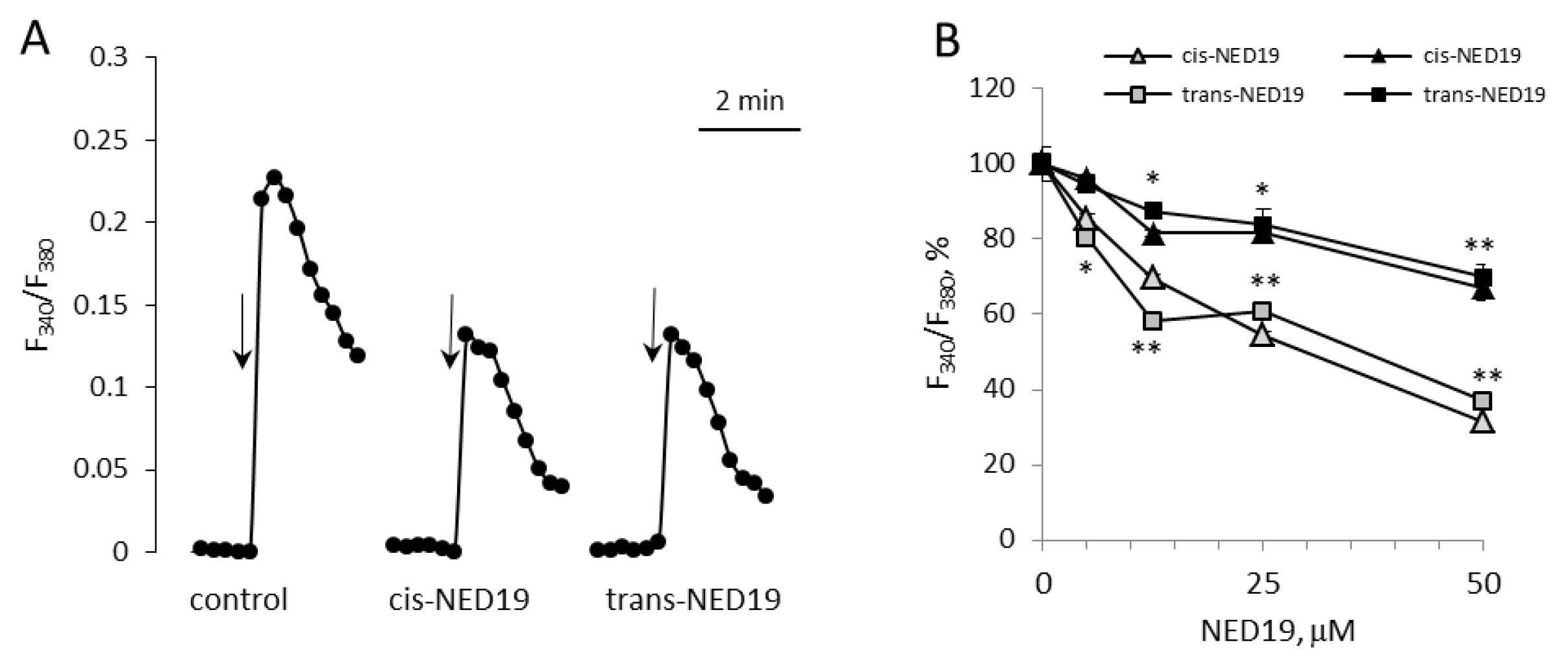
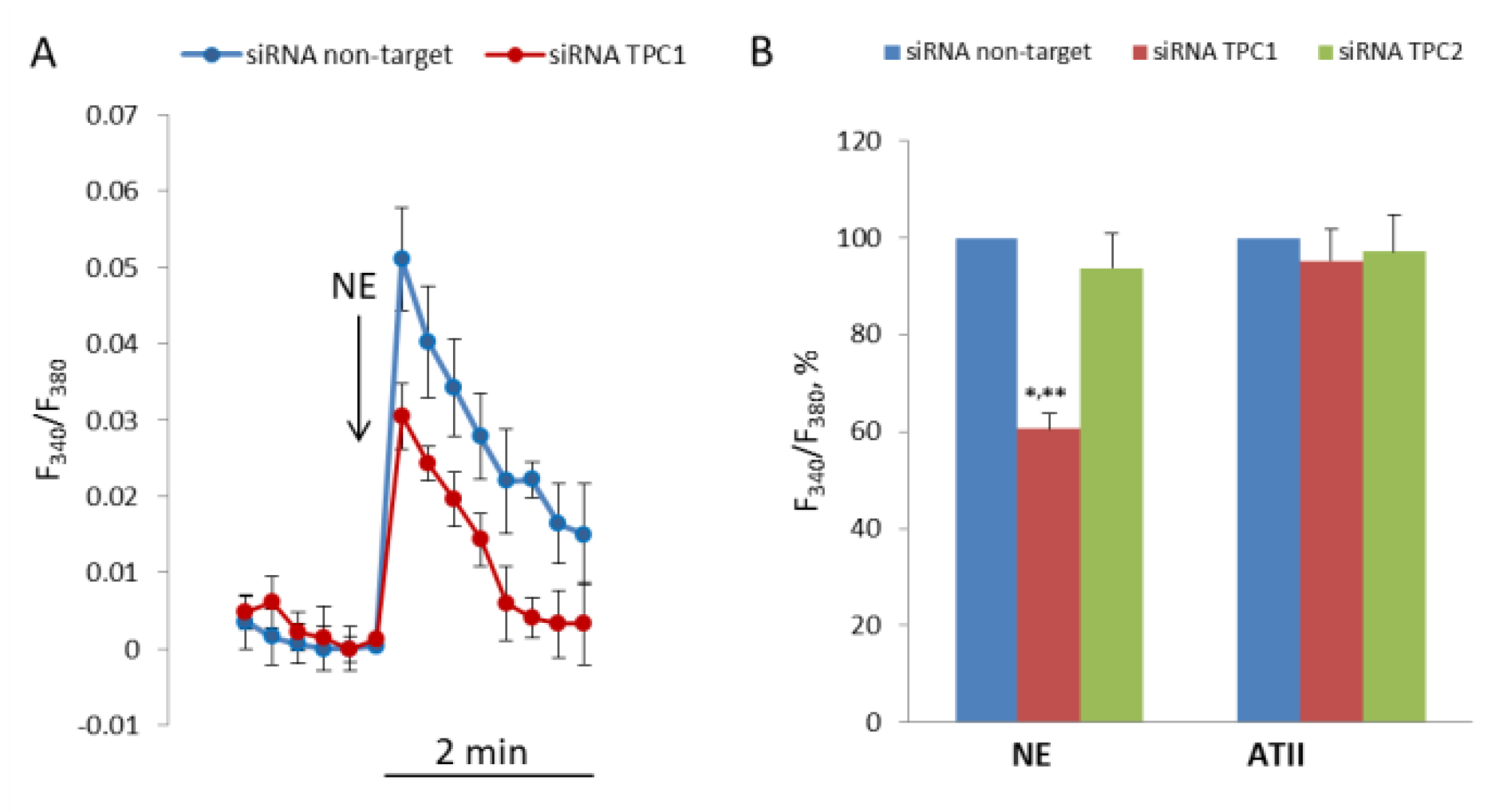

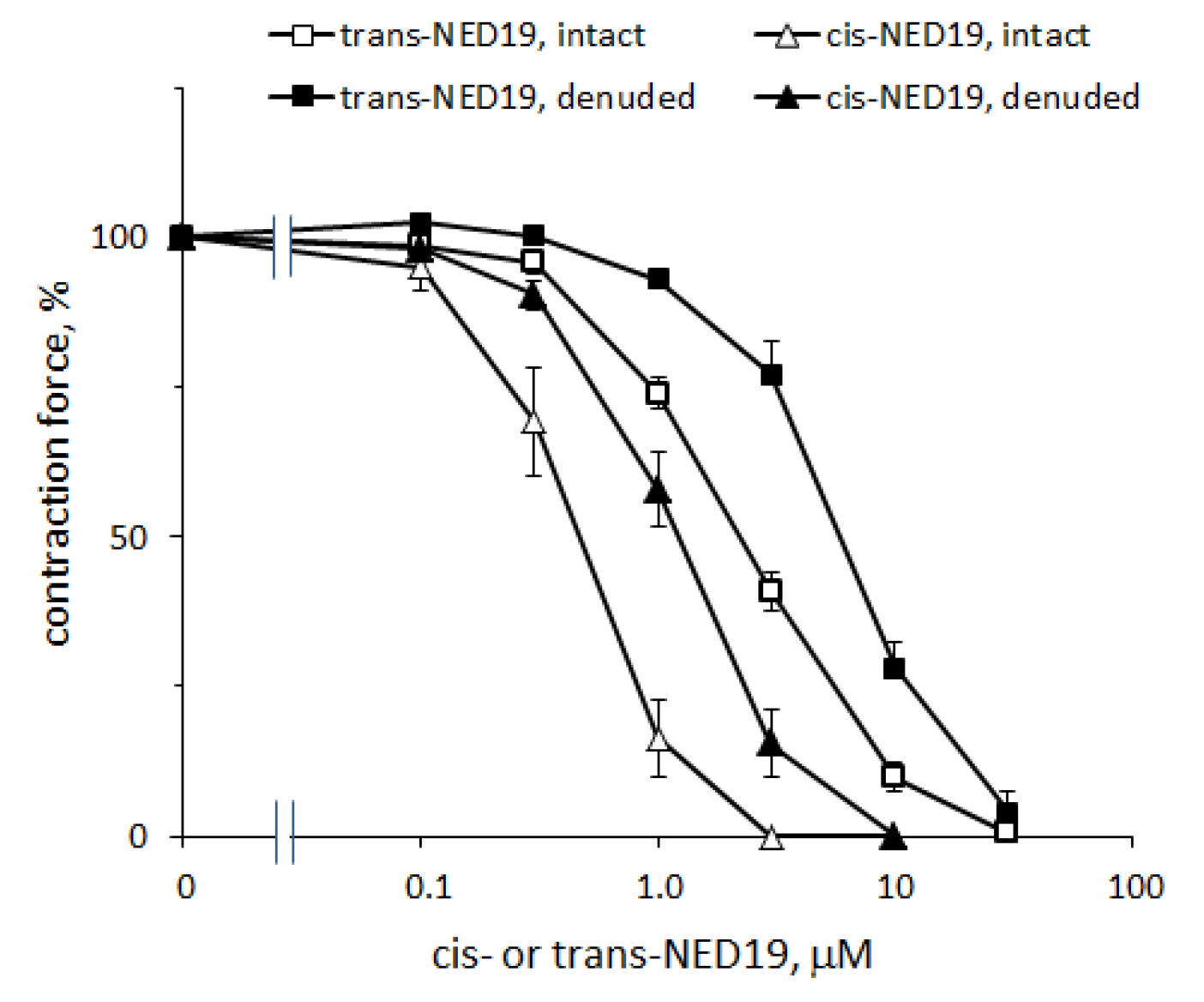
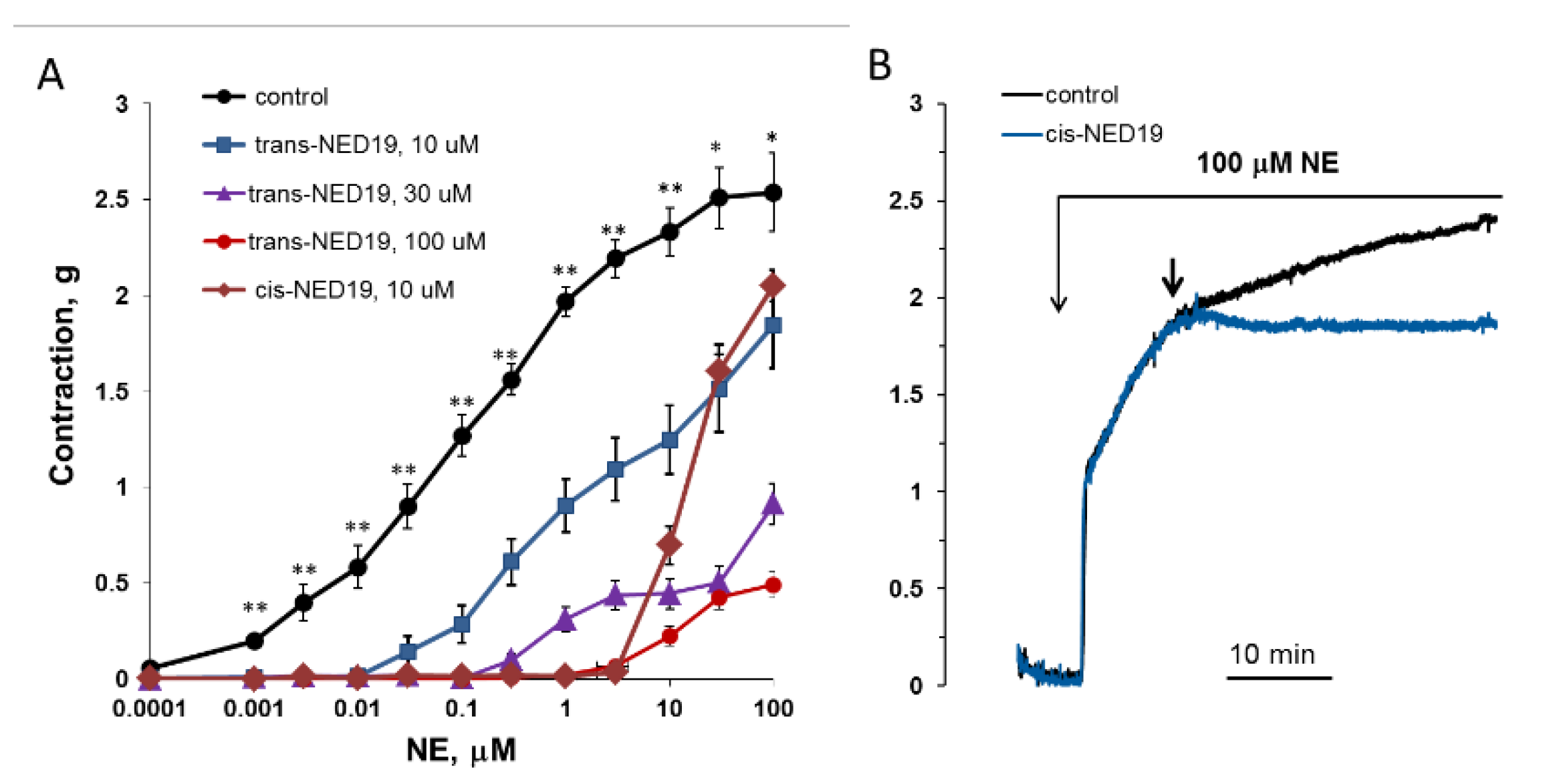
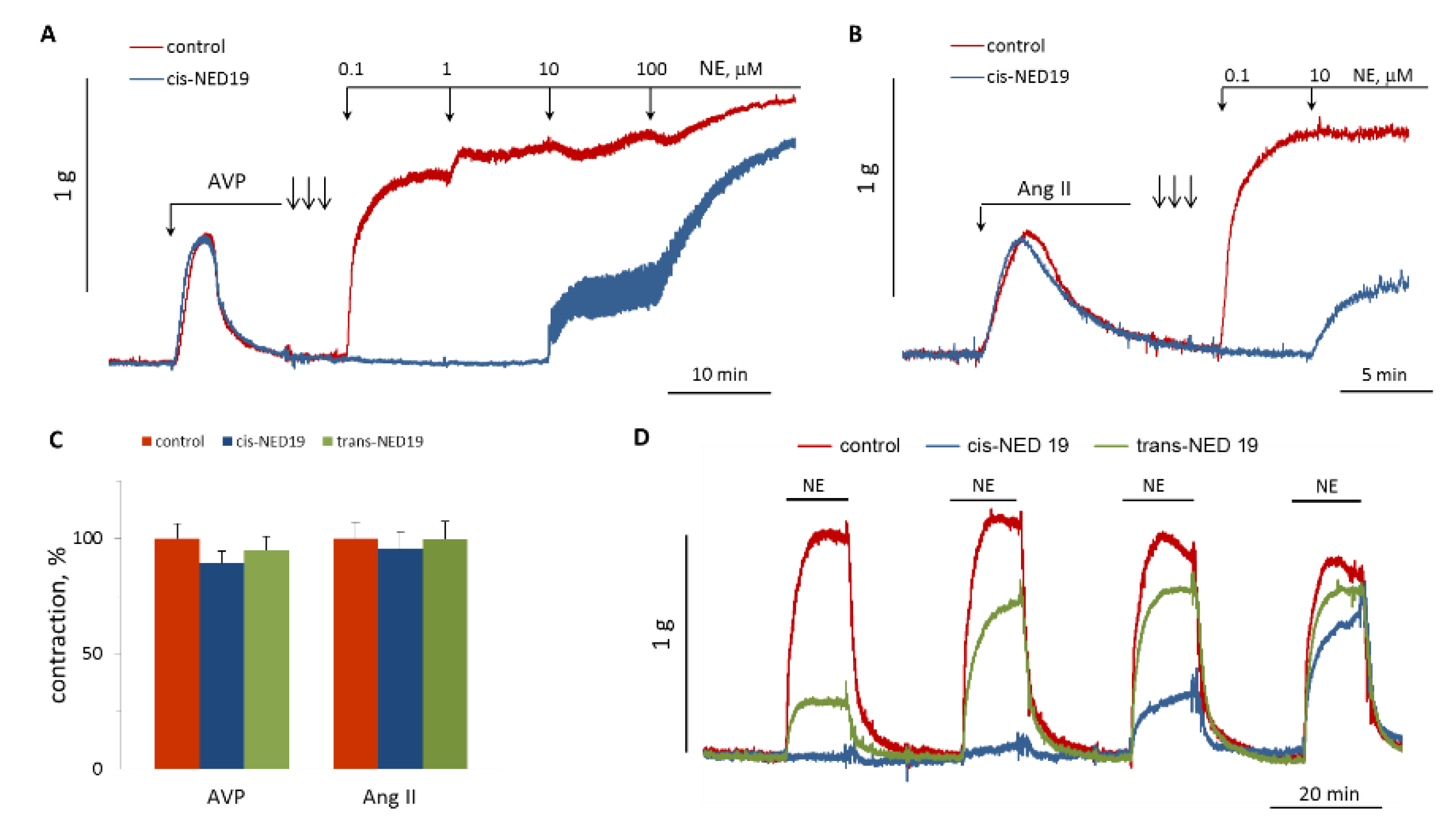
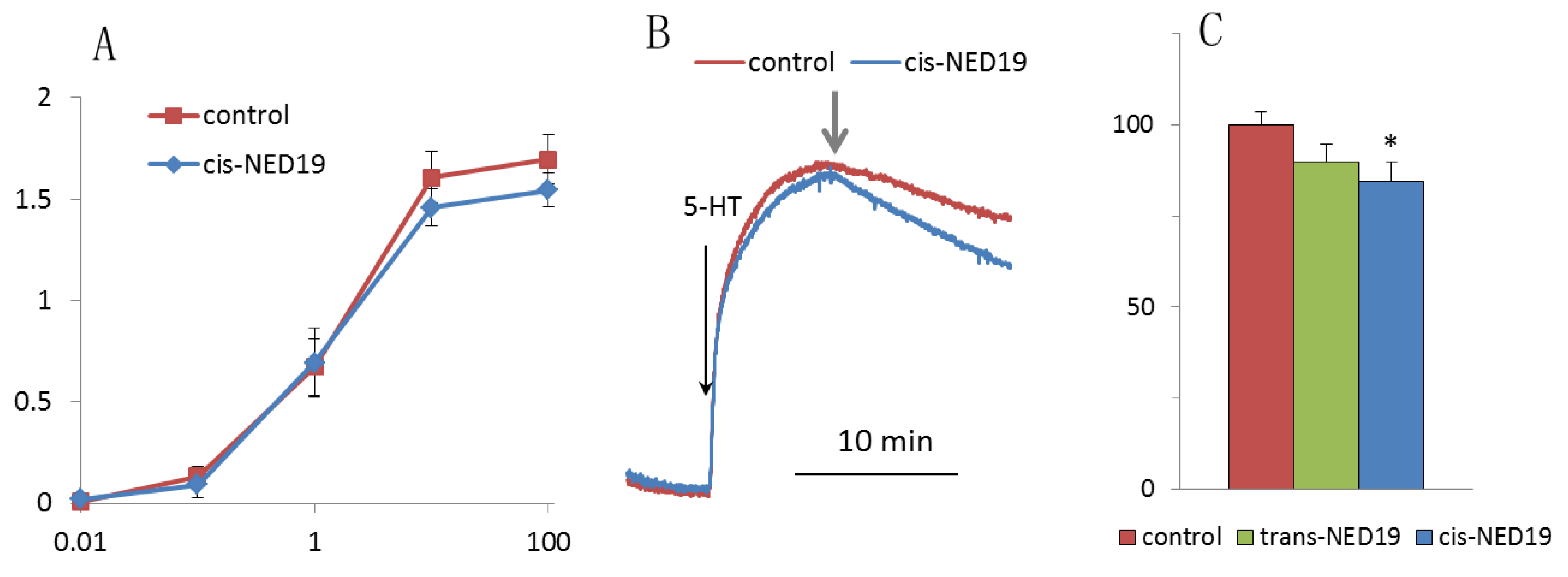
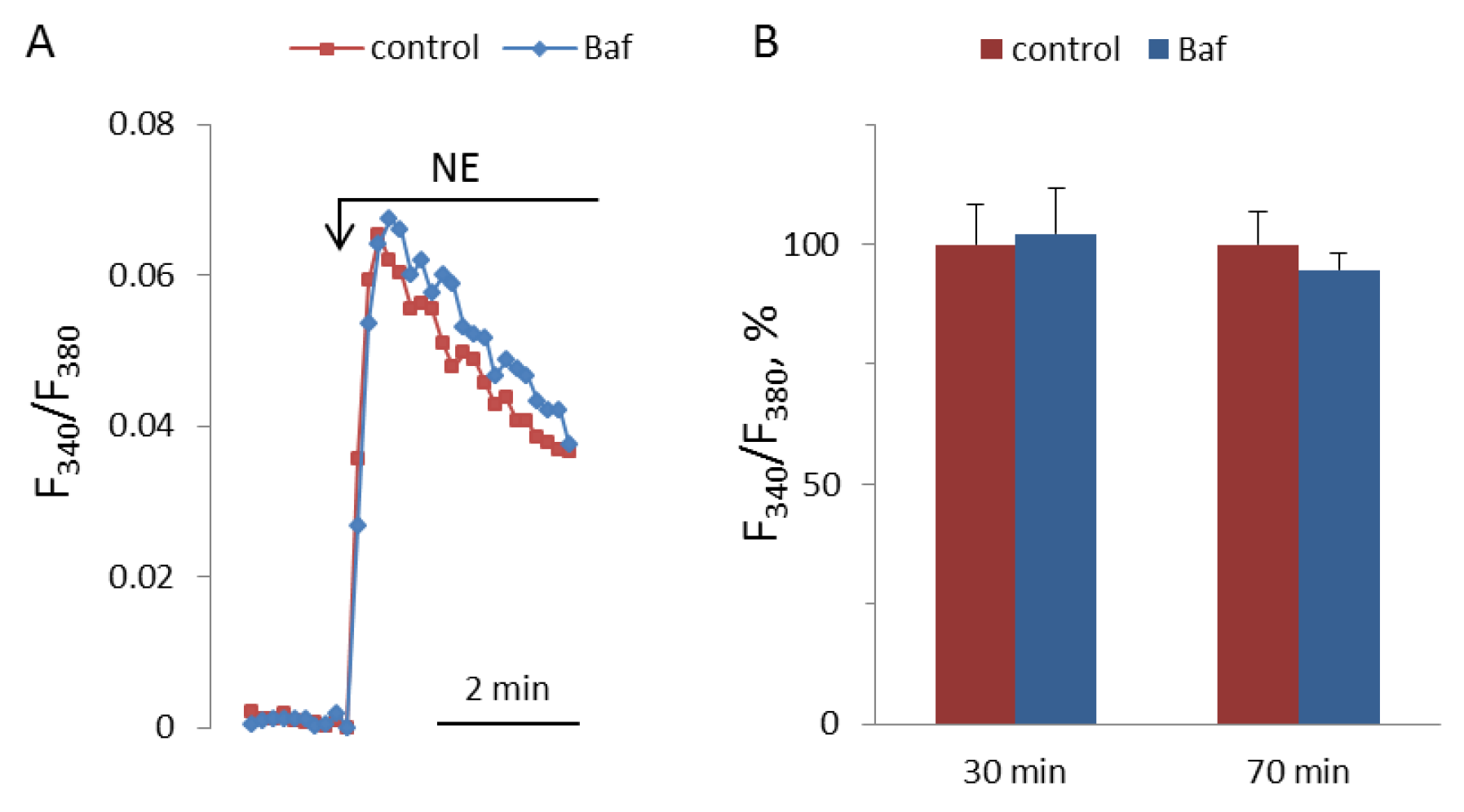
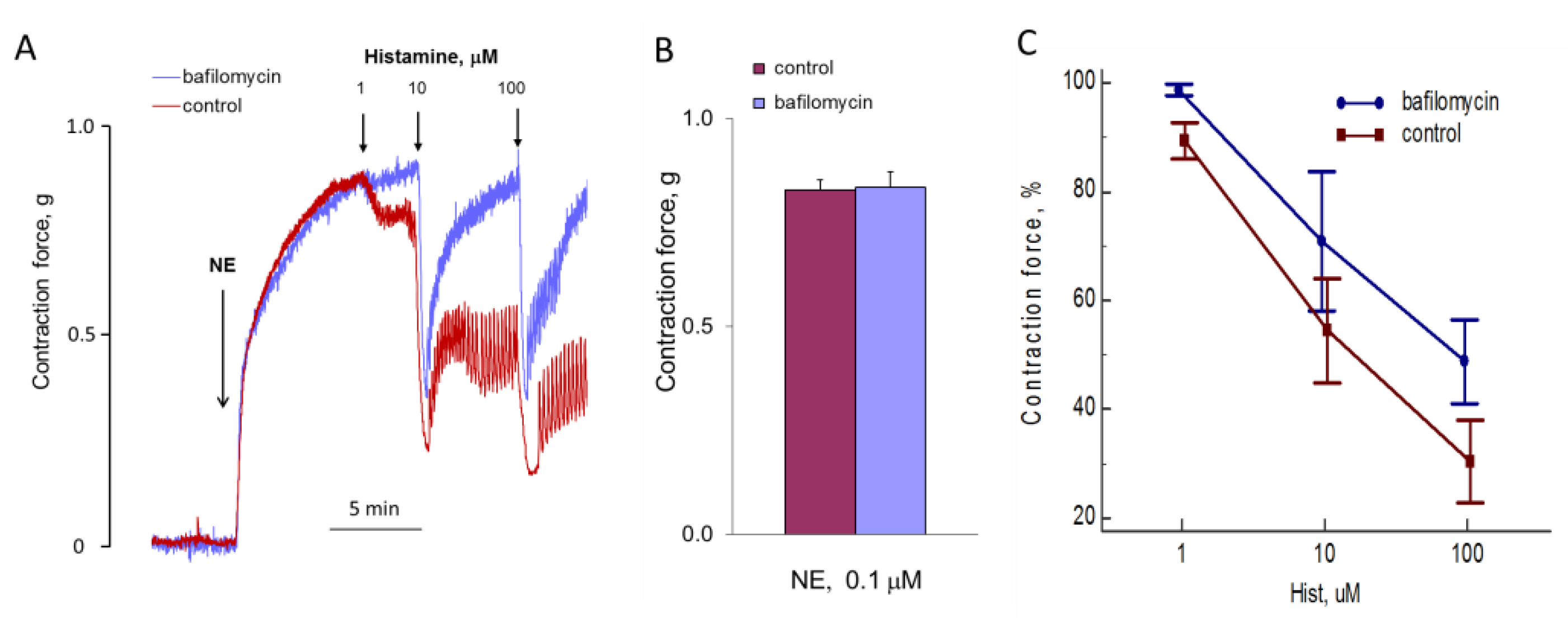
| Lysosomes | NED-Positive Vesicles | |
|---|---|---|
| RWC NED | 0.703 ± 0.0005 | 0.63 ± 0.0006 |
| RWC Lysotracker | 0.707 ± 0.0005 | 0.63 ± 0.0005 |
© 2019 by the authors. Licensee MDPI, Basel, Switzerland. This article is an open access article distributed under the terms and conditions of the Creative Commons Attribution (CC BY) license (http://creativecommons.org/licenses/by/4.0/).
Share and Cite
Trufanov, S.K.; Rybakova, E.Y.; Avdonin, P.P.; Tsitrina, A.A.; Zharkikh, I.L.; Goncharov, N.V.; Jenkins, R.O.; Avdonin, P.V. The Role of Two-Pore Channels in Norepinephrine-Induced [Ca2+]i Rise in Rat Aortic Smooth Muscle Cells and Aorta Contraction. Cells 2019, 8, 1144. https://doi.org/10.3390/cells8101144
Trufanov SK, Rybakova EY, Avdonin PP, Tsitrina AA, Zharkikh IL, Goncharov NV, Jenkins RO, Avdonin PV. The Role of Two-Pore Channels in Norepinephrine-Induced [Ca2+]i Rise in Rat Aortic Smooth Muscle Cells and Aorta Contraction. Cells. 2019; 8(10):1144. https://doi.org/10.3390/cells8101144
Chicago/Turabian StyleTrufanov, Sergei K., Elena Yu. Rybakova, Piotr P. Avdonin, Alexandra A. Tsitrina, Irina L. Zharkikh, Nikolay V. Goncharov, Richard O. Jenkins, and Pavel V. Avdonin. 2019. "The Role of Two-Pore Channels in Norepinephrine-Induced [Ca2+]i Rise in Rat Aortic Smooth Muscle Cells and Aorta Contraction" Cells 8, no. 10: 1144. https://doi.org/10.3390/cells8101144





